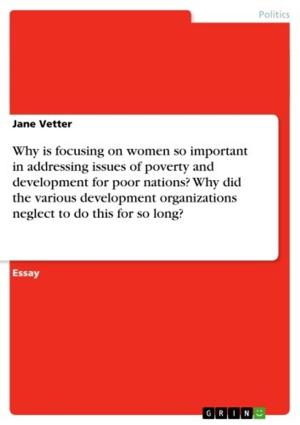What factors determine the supply of prostitutes?
What difference has effective contraception made, if any? What factors affect the demand for prostitutes? What difference has the sexual revolution made, if any?
Business & Finance| Author: | Florian Christian Weber | ISBN: | 9783638039185 |
| Publisher: | GRIN Publishing | Publication: | April 22, 2008 |
| Imprint: | GRIN Publishing | Language: | English |
| Author: | Florian Christian Weber |
| ISBN: | 9783638039185 |
| Publisher: | GRIN Publishing |
| Publication: | April 22, 2008 |
| Imprint: | GRIN Publishing |
| Language: | English |
Essay from the year 2004 in the subject Economics - Other, grade: 16 von 20, University of St Andrews (Economics and Finance), course: Economics of Social Life, 11 entries in the bibliography, language: English, abstract: Prostitution is meant to be the oldest profession, whether this is true or not, cannot really be distinguished, however the fact is that this phenomenon can be observed since ages. For example Jesus saved a prostitute from being lapidated and forms of commercial sex can be observed in the times of the old Greeks and Romans (Posner 1992). In the medieval ages, in Germany, prostitution was organised by guilds, regulated by the authorities. It was proscribed, however, not denied or oppressed. Even the brothels were often property of the city (Hiscott: 2001). Also in other countries at this age, prostitution flourished. A major reason was that there were hordes of bachelors (Posner 1992) After the breakout of syphilis in Europe and when the reforming theology gained more influence prostitution was oppressed. This repression lasted till the 19th century and with the industrial revolution the number of prostitutes increased rapidly. In Germany at the beginning of the First World War about 330,000, which is about 1% of the female population, were prostitutes (Reichel and Topper 2003). Nowadays the number of prostitutes is higher in less developed countries however not insignificant in developed ones (Philipson and Posner 1993). The number of prostitutes in Germany is estimated by the government at 150,000 (Morell 1998) and according to the Financial Times 25,000 prostitutes work in Amsterdam. This essay will discuss the supply and demand for prostitutes. Initially, some essential information about prostitution is presented. Secondly, the supply of prostitutes is discussed in the sense of what determines it and if effective contraception had any influence on it. Thirdly the demand side of prostitution is examined with respect to the influence of the sexual revolution. Finally, I give concluding remarks about the topic.
Essay from the year 2004 in the subject Economics - Other, grade: 16 von 20, University of St Andrews (Economics and Finance), course: Economics of Social Life, 11 entries in the bibliography, language: English, abstract: Prostitution is meant to be the oldest profession, whether this is true or not, cannot really be distinguished, however the fact is that this phenomenon can be observed since ages. For example Jesus saved a prostitute from being lapidated and forms of commercial sex can be observed in the times of the old Greeks and Romans (Posner 1992). In the medieval ages, in Germany, prostitution was organised by guilds, regulated by the authorities. It was proscribed, however, not denied or oppressed. Even the brothels were often property of the city (Hiscott: 2001). Also in other countries at this age, prostitution flourished. A major reason was that there were hordes of bachelors (Posner 1992) After the breakout of syphilis in Europe and when the reforming theology gained more influence prostitution was oppressed. This repression lasted till the 19th century and with the industrial revolution the number of prostitutes increased rapidly. In Germany at the beginning of the First World War about 330,000, which is about 1% of the female population, were prostitutes (Reichel and Topper 2003). Nowadays the number of prostitutes is higher in less developed countries however not insignificant in developed ones (Philipson and Posner 1993). The number of prostitutes in Germany is estimated by the government at 150,000 (Morell 1998) and according to the Financial Times 25,000 prostitutes work in Amsterdam. This essay will discuss the supply and demand for prostitutes. Initially, some essential information about prostitution is presented. Secondly, the supply of prostitutes is discussed in the sense of what determines it and if effective contraception had any influence on it. Thirdly the demand side of prostitution is examined with respect to the influence of the sexual revolution. Finally, I give concluding remarks about the topic.















